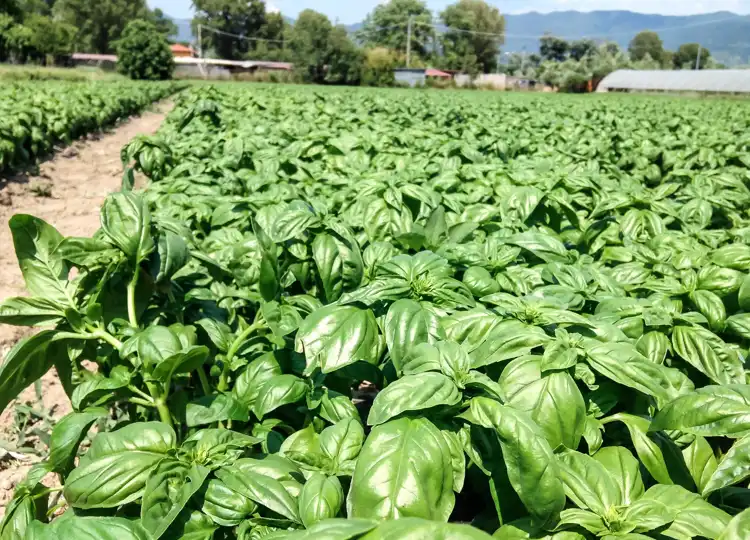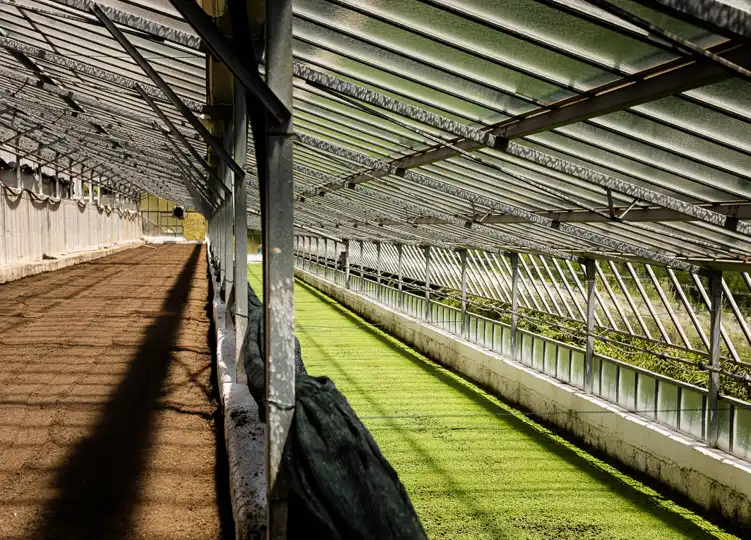Published:
Author: Antonio Maria Guerra
Genovese Basil PDO
HISTORY, INFO, PLACES, INTERESTING FACTS

Genovese Basil is a plant with an intense fragrance and unmistakable flavor: features it owes to the place where it grows, Liguria region. Its delicate, green leaves contain so much tradition they have become one of the symbols of Italian cuisine in the world, a fundamental ingredient of some of the most typical specialties from the Belpaese, such as pesto. In this article, also thanks to the valuable collaboration of the Consortium of its most traditional producers, we will deepen our knowledge of this delicacy, from its origins to the cultivation methods, explaining the reasons for such fame.

What is Genovese Basil?
Genovese basil is a particular selection (NOT a variant) of the annual basil plant (‘Ocimum Basilicum’), belonging to the Labiatae (or Lamiaceae) family. As it’s easy to understand from its name, it grows in the Genoa surrounding area and, more generally, in the territories on the Tyrrhenian side of Liguria. The discovery of its great value in gastronomy is closely linked to the invention and spread of Pesto Genovese, the condiment that has become famous all over the world, of which it’s the main ingredient.
Liguria: the cradle of Genovese Basil PDO
Genovese Basil PDO grows in the territories bordering the Tyrrhenian side of the Italian region of Liguria. This portion of the country has become famous thanks to its beautiful cliffs, small bays, and attractive little beaches, among which you can find charming seaside villages (the ‘borghi’) such as Portofino and Camogli, which, not surprisingly, have become desirable destinations for international tourism. The climate of these places, mild for most of the year, favors the development of lush Mediterranean vegetation.

The origins of basil.
Basil (Ocimum Basilicum), is a plant widespread in many areas of the world, whose origins are lost in a very distant past. Some academics speculate that this plant could come from India (*1): in this regard, it’s necessary to refer to one of the earliest written testimonies that have come down to us, which mentions its use in Ayurvedic medicine.
The ancient Egyptians used basil, among other things, in the process of embalming bodies (*2) and in religious ceremonies. Sometime later, the Greeks themselves would attribute a strong mystical value to
it, employing it in the commemoration of the dead (*3): they called it ‘basilikon phyton’ (‘royal plant’), probably because it was an ingredient for medicines and/or fine perfumes. Thanks to the Romans basil spread to the Italic peninsula: among its many merits, they recognized its aphrodisiac properties.
It was necessary to wait until the Renaissance period for a structured use of basil in gastronomy. However, it took several years for it to become established: suffice it to say that the first recipe to
make extensive use of it, the famous ‘pesto’, dates back to the 1800s (*4). It was thanks to this sauce, invented in Genoa, that the fortunes of a specific variety of the vegetable, today’s Basilico Genovese, fundamental to its preparation, began.
Since then, the milestones in the history of Genoese Basil were the assignation of the Protected Designation of Origin (PDO) in 2005 and the founding of the Consortium of the most traditional producers in 2008.
Notes:
*1: Or, alternatively, from the eastern part of Asia;
*2: As proved by the findings in many tombs;
*3: They were convinced that it could ease the opening of the gates of heaven;
*4: At least in the form we know and appreciate nowadays;
*5: There is a specific reference to ‘Pesto alla Genovese’ (the classic one, because there are many variants of it).

Basil: the origins of the name.
The English word ‘basil’ (in Italian, ‘basilico’), derives from the Latin ‘basilicum’, which is itself a development of the Greek ‘basilikón’ (βασιλικόν). The meaning of the latter is ‘royal’ or ‘of the king’, clearly referring to the great value that has always been attributed to the plant, not surprisingly used since ancient times to officiate religious ceremonies.


Basil and ‘basilisk’.
Some claim, although there is no certainty about it, that the name ‘basil’ is somehow related to that of a mythological creature: the basilisk (from the Greek basiliskos, ‘little king’). In this regard, the similarity between the two words is undeniable. It should be added that in ancient times the plant, known for its healing properties, was considered an effective antidote for the venom of the animal: an incredibly dangerous being, nicknamed the ‘king of snakes’, that could petrify its poor victims with a mere glance.

The cultivation of Genovese Basil PDO.
The technical knowledge necessary for the cultivation of Genovese Basil PDO is of paramount importance: not by chance, it is included in the product specification document. This particular selection of plants can be grown both outdoors, during the summer season, and in special greenhouses, during the winter months. Their high density is also fundamental, as it increases the tenderness and fragrance of the leaves.
While in warm weather twenty days are enough for the complete maturation, in cold weather it can take more than forty.
Notes:
*1) For greenhouse-grown basil, this density is achieved using a particular sowing technique (‘a spaglio’), performed strictly by hand;

The production types of Genovese Basil PDO.
The specification document of Genovese Basil PDO includes two types of product:
One is intended for fresh consumption: the plants, often grown in greenhouses, are harvested strictly by hand and packaged in bouquets that are put on sale immediately;

The other is intended for processing: the plants are generally grown outdoors and harvested with special machinery, ready to be shipped to the food industry;

The unique characteristics of Genovese Basil PDO.
Basil Genovese is a particular selection of basil that stands out in several ways, starting with its appearance, which is characterized by small to medium-sized, light-green, oval-shaped leaves. As for its scent, it should be pointed out that it lacks the slight hint of mint that can generally be detected in this type of plant. These peculiarities earned the assignment of the PDO mark (Protected Designation of Origin) in 2005 by the European Union, which, by this recognition, wanted to emphasize the indissoluble link between the product and its territory of origin.

Genovese Basil PDO for Genovese Pesto.
As it is easy to understand from their very name, the relationship between Genovese Pesto and its main ingredient, Genovese Basil PDO, is very close. The condiment, which has become very famous in the world, is prepared by crushing the leaves of the plant, to which are added Parmigiano Reggiano cheese (Parmesan), pine nuts, garlic, salt, and extra virgin olive oil. There is no doubt that the real secret of the success of this simple and tasty recipe lies in the quality of the raw material used in it.

Aldo Fabrizi praises basil.
Aldo Fabrizi, the famous Roman actor who starred in many successful movies between the 1940s and 1970s, was such an admirer of basil and its qualities to dedicate a sonnet in dialect to it. Here is a brief excerpt:
Read more
“A parte che er basilico c’incanta perché profuma mejo de le rose, c’ha certe doti medicamentose che in tanti mali so’ ’na mano santa …”
(“Besides the fact that basil enchants us because it smells better than roses, it has certain medicinal properties that are just perfect for many diseases …”)

The Product Specification of Genovese Basil PDO.
After many years characterized by great confusion, the assignation of the PDO mark has defined clearly the requirements that Genovese Basil PDO must meet. These requirements, included in the Product Specification document, include:
Read more
- The type of seed used, which must belong to the species Ocium Basilicum;
- The characteristics of the plant, such as its height, as well as the density and shape of the leaves;
- The aroma, which must be “intense and characteristic” (cit.), completely devoid of the taste of mint;
- The production area, identified in the Tyrrhenian side of the Liguria Region;
- The optimal environment for cultivation, which can take place either outdoors or in a greenhouse;
- The packaging of the fresh product, including the display of the consortium logo;
For more information, you can read the specification document itself (in Italian language).

The international success.
One of the greatest benefits associated with the assignment of the PDO mark to Genovese Basil and the adoption of a proper specification document has been that the product has acquired a strong identity with which to present itself on the international market. At present, its sales are on the rise in northern Europe and especially in the United States (the leading foreign importer), where its specific characteristics and great quality are increasingly recognized.

The Genovese Basil PDO Consortium.
The Genovese Basil PDO Consortium, including dozens of the most traditional Ligurian producers, is delegated to the protection of the product, ensuring that its characteristics are preserved, and to the promotion, taking care of its image in the world.
Some useful information:
Contacts
Genovese Basil PDO Consortium
Address: Salita Santa Caterina 50/52R 16123 Genova (GE)
Official website: www.basilicogenovese.it
Mail: info@basilicogenovese.it
Tel.: +39 333 2194908
Copyright information.
The images displayed in this page belong to WebFoodCulture and to the Genovese Basil PDO Consortium, with the exception of:
Public Domain Images
- PDO Logo ;
- Aldo Fabrizi in a shot from the Italian movie ‘La famiglia Passaguai’ (1951)
- Portrait of a young woman, Botticelli, 1480-1485.
- Basilisk, XII Sec.
- US Flag.
Creative Commons Images
- Basil, by Goldlocki, is licensed under Creative Commons Attribuzione 3.0 Unported
- Pesto, by M, is licensed under Creative Commons Attribution-Share Alike 3.0 Unported
- Bouquet di Basilico Genovese DOP, by Elisa Traverso is licensed under Creative Commons Attribution-Share Alike 4.0 International.
- Dhanvantari, by HPNadig is licensed under Creative Commons Attribution-Share Alike 3.0 Unported.
- Basilico by SteGrifo27 is licensed under CC BY-SA 3.0.
- Bouquet di Basilico Genovese DOP by Daniela Traverso is licensed under CC BY-SA 4.0.
- Pesto di Basilico by Ɱ is licensed under Creative Commons Attribution-Share Alike 3.0 Unported.






